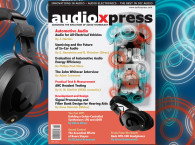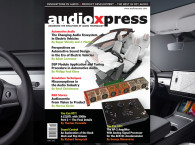
You are driving through the city with your favorite song streaming from Spotify. The voice assistant warns of traffic congestion ahead, received through a Vehicle2Vehicle message — then the telephone rings and you use the hands-free system to take the call, while the acoustical vehicle alert system (AVAS) alerts pedestrians of your oncoming vehicle.
Everyday scenes such as that make one thing clear: Automotive audio systems and their embedded services are becoming increasingly important. FM/AM radio, hands-free-telephony, and media playback found their way into all vehicle segments a long time ago — on top of these, there are concierge services, multichannel streaming services, AVAS, emergency call systems, and in-car communication services gaining ground in cars (just to name a few). The overall system complexity is constantly increasing, and with it also to some degree the system’s energy consumption of the cars they are built into.
Premium-branded sound packages are what the customers want and they are willing to pay for them. In some luxury cars, the premium sound packages are beside performance upgrades as the most expensive extras. Increasing amounts of money are being spent by customers on cars with what seems like an almost per model year growing number of loudspeakers and amplifier channels. Twenty or more speakers are no longer a rarity. The current BMW iX offers optionally up to 30 speakers.
On the other hand, due to legal requirements and advancing developments of infotainment functions, OEMs are transferring more and more functions to audio systems. After all, this equipment increases the attractiveness of the vehicle in many ways and offers interesting sales margins to OEMs and suppliers alike.

What About Energy Consumption?
At the specification stage, automotive audio engineers don’t often have energy consumption and efficiency on their top priority list. Besides traditional measurements of quiescent current and maximum power output for speakers, the test protocols provided by the International Electrotechnical Commission (IEC), Deutsches Institut für Normung e.V. (DIN), which is a German Institute for Standardization; similar to US ANSI, and the Consumer Technology Association (CTA) are not holding much in terms of measurement of efficiency and power consumption of consumer devices and complete audio systems.
Yet this is an important factor, through the million-fold scaling in the vehicle fleet. Even minimal amendments to the design of electric loads can have an enormous effect on overall energy consumption. Even if only a minimal amount is saved in one car, while these amounts might at first glance seem insignificant and super small, they can have a big impact on overall emissions of a car fleet.
Considering that about 90 million cars were sold worldwide in 2021. How can the electrical energy consumption of in-car systems be measured in a way that is repeatable, comparable, and conclusive? The Automotive Audio Energy Efficiency Test Cycle (AAEETC) provides a solution to this. This test cycle measures the power used by various audio sources (entertainment, telephone, warning sounds, etc.) with clearly defined boundary conditions and a modeled user.

Electric Cars Are Gaining Ground
There is a further development that makes looking at the electrical energy consumption of audio systems important: The advent of electric cars. With the introduction of a wide variety of partially or all-electric powertrains in form of 48V mild hybrids, serial and parallel plug-in hybrids (PHEVs), battery electric vehicles (BEV) and fuel cell/hydrogen vehicles (FCEV) will bring about a radical transformation of the automotive market in the foreseeable future.
Through the influence of government subsidies, high fuel prices, geopolitical interests and a general environmental awareness (which is more and more influencing consumers in their buying decisions in emerging and developed markets), the worldwide market share of electric cars is on the increase. The development of sustainable products is thus becoming more and more important and using a standardized process to measure the power consumption of audio systems is only one of the many enablers here needed. Product development engineers will be able to make better decisions, and therefore make a positive contribution in terms of sustainability. Measurement enables management.
Every Additional Watt Has a Negative Impact on Range
Why every watt counts with electric cars can be seen in a simple comparison with combustion engines. Fuels can be stored relatively easily in synthetic material containers. Converted into electrical dimensions, an eighth generation Volkswagen Golf (2021 model year) equipped with a standard 50-liter (13.2 US gallons) tank can carry 488kWh worth of energy (1 liter of petrol = 9.76kWh). A tank of the 2021 model of the bestselling vehicle in North America, the Ford F150 (optional equipment), can carry up to 136 liters (36 US gallons). This is equivalent to an impressive 1,327kWh.
Electric cars are very different in that matter: The largest battery in a car currently for sale (Mercedes-Benz EQS) has a capacity of approximately 110kWh gross. Although electric cars make an outstanding impression due to the greater efficiency of their powertrains, the total volume of usable energy is still substantially lower than that of vehicles with combustion engines.
In cold climates, the range is depleted through rising internal resistances in the battery and heating losses. When developing automotive electrical and electronic (E/E) components, vehicle manufacturers must pay close attention to the consumption of the electrical components and their efficiency. Every additional watt has a negative impact on range, charging time and a direct influence on the sustainability of the vehicle throughout its entire life cycle.
Saving the Annual CO2 Emissions of a Small Car Fleet
But how does an audio system affect the energy consumption of a battery electric drive system? It is worth having a look at a few figures for the EU here provided by reliable sources.
The average consumption of the top 10 electric vehicles sold in Europe 2021 (charging loss not included) [1], [2] is 18.03kWh/100 km (3.44mi/kWh), while 11,964km [3] (7434 miles) are driven by the average European, traveling at a speed of 45km/h [4] (28mph). The generation of one kilowatt-hour (kWh) of energy in the EU results in the emission of an average of 317g (0.698lbs.) of CO2 [5] (with a very strong falling tendency).
This means that for the operation of an electric car 2,157kWh/year must be sourced (charging loss not included), leading to emissions of 683kg CO2 a year. In 2020, a total of 1.4 million electric vehicles were sold in Europe [6]. If the electric and electronic design of these vehicles were to be altered in such a way that the continuous power usage was reduced by just 1W (-0.01235%), then this would result in a total saving of 118,090 metric tons of CO2 per year of operation. This is equivalent to the total annual emissions produced by 173 electric vehicles or 105 average EU households!
A further advantage is that, compared to the task of improving powertrain efficiency or aerodynamics, small modifications can be made to the E/E components quickly and can then be relatively easy integrated into existing series production cars.

Suggestion for the Automotive Audio Energy Efficiency Test Cycle (AAEETC)
How could a power-saving change like that be verified? Audio systems in vehicles are put to different use by different people: Some listen to loud music, others use the radio a lot, telephone a great deal, or perhaps use no audio sources at all when they are driving. When it came to a standardized usage test, the challenge was to take all these variables and find a mean value.
A similar challenge was also posed by the development and incorporation of the standardized test procedures for type certification for the measurement of consumption values (NEDC, WLTP, and GB T CLTC). Although the individual is not well represented by the model here, the test results allow for comparability between the competitors within a vehicle segment and meaningfulness and reproducibility between the test runs. These conditions can be transferred to the AAEETC.

Test Description of the AAEETC
In order to start the test, the tested system must be booted and ready for use. If specific filters are applied for some sources (“tunings” or EQ sets) these must be activated in the test case concerned (e.g., when the telephone is tested, the telephone filters must be active). A stabilized supply voltage of 14V to 14.4V must be provided to the DUT. To measure the current inflow, a current measurement device with an activated logging function must be used. A constant temperature of 20°C must be kept during the 60 minutes of test run (Table 1).
The AAEETC is a tool for developers and a suggestion of how the energy consumption of audio systems might be reproducibly and reliably measured and evaluated. Building on this, improvements on the circuit or system design can be carried out. Great potential for future improvement in system energy efficiency lies in the application of GaN-based amplifiers and multi-stage amplification circuitry. The savings expected here can easily exceed the 1W of the example calculation (Figure 3).
It is planned that the AAEETC test cycle will be further improved in the future through anonymously determined usage data of OEMs and providers of mobility services. The development to make the AAEETC system test a unit test for amplifier development only through the specification of a standard speaker set is also under way.
In addition, the measurement results of the AAEETC could also be used for greater transparency for the consumer in marketing materials. A fairer comparison then the “I have more watts than you” spec rivalry between competing cars could become possible. aX
References
[1] Sales figures by JATO Dynamics, www.jato.com/germany/car-sales-germany
[2] Calculation and comparison of fuel consumption through own calculations, Spritmonitor.de, www.spritmonitor.de
[3] Odyssee-Mure, “Change in Distance Travelled by Car,”
www.odyssee-mure.eu/publications/efficiency-by-sector/transport/distance-travelled-by-car.html
[4] European Commission “Driving and parking patterns of European car drivers – a mobility survey,” https://publications.jrc.ec.europa.eu/repository/handle/JRC77079
[5] Fraunhofer ISE, https://energy-charts.info
[6] “More than 500,000 full electric cars sold so far this year in Europe,” The Guardian, www.theguardian.com/business/2020/dec/03/more-than-500000-full-electric-cars-sold-in-europe-in-10-months
This article was originally published in audioXpress, June 2022






